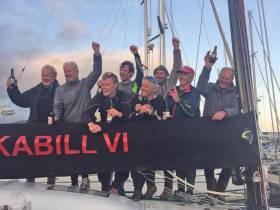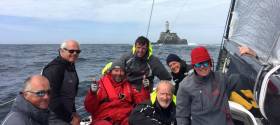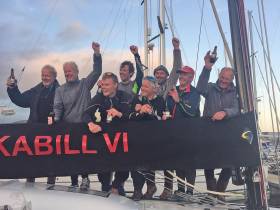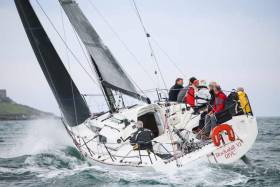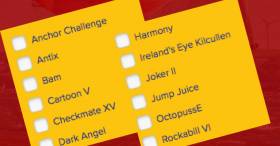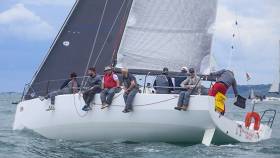Displaying items by tag: Rockabill VI
Royal Irish JPK 10.80 Rockabill VI skippered by Paul O'Higgins reigned in Saturday's first ISORA cross channel IRC race for over two years but with a winning margin of less than a minute after nine hours on the water.
The Dun Laoghaire yacht – which has won all its ISORA fixtures this season – had just 52 seconds over Welsh rival J109 Mojito, skippered by Peter Dunlop and Vicky Cox.
The yachts finished under spinnaker in light airs at tea time at Dun Laoghaire Harbour with respective corrected elapsed times of 9 hours 34 minutes and 28 seconds and 9 hours, 35 minutes and 20 seconds.
 17 ISORA boats raced across the Irish Sea on a 59-mile course from Holyhead to Dun Laoghaire Screenshot: YB Tracker
17 ISORA boats raced across the Irish Sea on a 59-mile course from Holyhead to Dun Laoghaire Screenshot: YB Tracker
From a pre-race billing of over 20, a fleet of 17 came to the line at Holyhead in North Wales on Saturday morning with 13 finishers of the Musto sponsored race on Dublin Bay.
The fleet sailed into fog off the Irish coast that reduced visibility so severely that it led to the cancellation of the bulk of DBSC racing on Dublin Bay but cleared briefly around 6 pm to let the leaders at least finish in relatively clear conditions.
The line honours winner was the Grand Soleil 44 Samatom (Robert Rendell) of Howth, who finished on a corrected time of 9.46.35 to take third overall on IRC.
 The line honours winner was the Grand Soleil 44 Samatom (Robert Rendell) Photo: Afloat
The line honours winner was the Grand Soleil 44 Samatom (Robert Rendell) Photo: Afloat
With IRC Zero victory going to Rockabill VI, second in the big boat division was Rendell's Samatom, with Andrew Hall's Pwhelli based J125 Jackknife second.
 The J109 Mojito (Peter Dunlop and Vicky Cox) was second in the line honours race at Dun Laoghaire Harbour Photo: Afloat
The J109 Mojito (Peter Dunlop and Vicky Cox) was second in the line honours race at Dun Laoghaire Harbour Photo: Afloat
Second to Mojito in IRC One division was Paul Sutton's sistership and Pwhelli clubmate, Jaydreamer. In a J109 clean-up in that division, Simon Knowles was third in the Howth Yacht Club J, Indian.
IRC Class 2, Pwllheli Sailing Club's Pete Ashworth's Sunfast 3200 beat Mark and Jo Thompson's Sunfast 3200i.
 Irish Sea Offshore Racing Association Results Race 05 - Class 0/1/2 IRC/ECHO
Irish Sea Offshore Racing Association Results Race 05 - Class 0/1/2 IRC/ECHO
Live Dublin Bay webcams here
Paul O'Higgins is Sailor of the Month (Offshore) for September
One of the many "little miracles" which kept Irish sailing alive and active during the continually-changing official restrictions in the summer of 2020 was the flexible and effective administration of the Irish side of the Irish Sea Offshore Racing Association's annual programme by ISORA Chairman Peter Ryan of the National YC.
But in order to succeed in this, he needed the support of the skippers and crews who enjoy what ISORA has on offer, yet in a normal year would be able to plan their programme well in advance.
This wasn't possible in 2020, but thanks to a generous spirit among those involved, the Irish boats in ISORA had a very good season in the circumstances. Once again it came down to the outcome of the last race in September, and once again the final race overall winner, and new 2020 champion, was Paul O'Higgins (Royal Irish YC) with the JPK 10.80 Rockabill VI.
The potent Dun Laoghaire-based JPK 10.80 Rockabill VI may now have four very busy seasons – both inshore and offshore - in her sailing CV. But the years have not dulled her performance and competitiveness, and in 2019 she had such a wellnigh perfect prize-list that her owner-skipper Paul O’Higgins has emerged as a clear winner of the Afloat.ie/Irish Sailing “Sailor of the Year 2019” title.
As most Afloat.ie readers will be aware, today was planned to see the Annual General Meeting of Irish Sailing in Dun Laoghaire, together with the Annual Conference of many of its specialist sub-groups, with the day’s business concluding in the honouring of the many and varied Sailors of the Month followed by the acclaimed announcement of the latest Sailor of the Year.
Normally this is done in early February. But times have changed in the structures of sailing and its sponsorship supports in recent years, and despite the late date, it was right for the circumstances that were in it for the ceremony to be put back by seven weeks.
But in those seven weeks, “the circumstances that were in it” have in turn been changed out of all recognition, and as we indicated last week with our report of the virtual launch of the SSE Renewable Round Ireland Race 2020, for now and the foreseeable future while Covid-19 dominates our lives, everything involving public ceremonial is going to be in the virtual world, or as the more senior among us still prefer to think of it, in cyberspace.
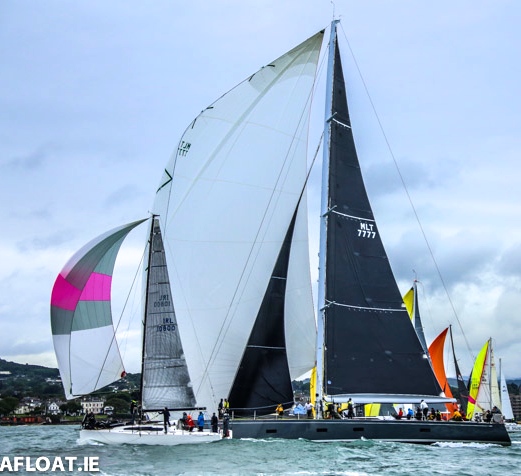 The start for something big….Paul O’Higgins’ JPK 10.80 Rockabill VI and Mick Cotter’s Southern Wind 94 Windfall at the start of the Dun Laoghaire to Dingle Race 2019 in which Windfall took line honours and a new course record, and Rockabill VI was overall winner. Photo Afloat.ie/David O’Brien
The start for something big….Paul O’Higgins’ JPK 10.80 Rockabill VI and Mick Cotter’s Southern Wind 94 Windfall at the start of the Dun Laoghaire to Dingle Race 2019 in which Windfall took line honours and a new course record, and Rockabill VI was overall winner. Photo Afloat.ie/David O’Brien
Call it what you may, but at the heart of it there are indisputable facts, and today there is longterm encouragement in contemplating just what Paul O’Higgins and his shipmates have achieved since 2016, and particularly during the past 12 months.
Of course, there’s a very special boat at the centre of it. And of course, her owner-skipper is renowned for surrounding himself with some of the most formidable talents in Irish offshore racing – both amateur and professional – drawn from a crew panel based around the Greater Dublin area and Cork, and based on a regular core crew.
Yet there are many boats of enormous potential in Ireland. And the talent is there at every sailing centre. But it takes a special ability, a very focused intelligence, and an extremely determined campaigner of the calibre of Paul O’Higgins to bring them all together race after race, regatta after regatta, to achieve results of the remarkable consistency logged by Rockabill VI.
The 2019 highlights alone are enough to set the tone: ICRA Nats: First Overall Coastal Class 0; Dun Laoghaire to Dingle Race: 1st overall and the first boat to successfully defend overall win in a previous race; Calves Week: 1st; Irish Sea Offshore Racing Association 2019 Championship: 1st Overall; Irish Cruiser Racing Association: Boat of the Year 2019.
Outside of sailing, Paul O'Higgins is best known as one of Ireland’s leading lawyers with a Dublin family background in which rugby and tennis were the favoured sports. But he reckons not being a cradle sailor gives a certain advantage, as he can look at boats in a coldly dispassionate way, uninfluenced by sentiment.
In fact, he hadn’t sailed at all until he met his future wife Finola Flanagan at College, and as the Flanagans of Skerries were the total sailing family, he soon found himself roped into sailing with his future father-in-law Jack Flanagan on a series of boats all named Rockabill after that distinctive lighthouse-topped rocky islet that is eight miles east of Skerries out in the Irish Sea, an islet big enough to provide a home for Europe’s largest colony of the rare roseate terns.
 The one and only original Rockabill eight miles off Skerries is home to Europe’s largest colony of roseate terns
The one and only original Rockabill eight miles off Skerries is home to Europe’s largest colony of roseate terns
From being a visitor who might pull a rope when asked, the daughter’s suitor developed into a crewman, and as his taste for this weird but wonderful sport grew, he became a partner in the continuing succession of Rockabills, going into co-ownership with Jack in a souped-up First 30, Rockabill II.
By 1998, the balance was changing naturally with the passage of time, and Paul was becoming the pace-setter when they moved into a First 33.7 Rockabill III. He was competitive, yet no more naturally able at sport than most. An enthusiasm for playing rugby had been brought to an end by a knee injury, but he can still give a reasonable account of himself on a tennis court. However, it was the hugely complex wind-driven vehicle sport of campaigning a cruiser-racer under fair handicap rules which increasingly appealed to him.
Having made the happy discovery that he seemed to be immune to seasickness, he stepped up his level of involvement. His father-in-law had long since become eligible for the free travel pass, so the stage was reached where Paul bought him out while still with the First 33.7, and then with the turn of the millennium he was thinking of another boat slightly further up the Beneteau range, the highly-regarded First 36.7, and with her he achieved his first significant win in an IRC event, by which time he had moved his base of sailing operations to Dun Laoghaire.
Professional and family life were at their most demanding, yet somehow he found the time to campaign the First 36.7 Rockabill IV in several significant series and regattas, building up both experience and skills, while at the same time enlarging his circle of like-minded friends to create the kind of crew panel – more than twice the number of actual crew on the day - which is necessary to campaign a serious boat at this level.
With every year, however, the level became ever more demanding, and in admitting to himself that the First 36.7 was no longer cutting the mustard at the heights to which he aspired, he reckoned by 2008 that he needed to be in a Corby, and a new Corby 33 was what he could most comfortably afford.
 With the Corby 33 Rockabill V, Paul O’Higgins had many successful years. She is seen here racing at the ICRA Nationals 2013 at Tralee Bay. Photo: Robert Bateman
With the Corby 33 Rockabill V, Paul O’Higgins had many successful years. She is seen here racing at the ICRA Nationals 2013 at Tralee Bay. Photo: Robert Bateman
Rockabill V, the Corby 33, became a familiar sight on the circuit, always noted for putting in an interesting and often podium-gaining position, as he’d linked up with that notably serious and singularly-talented sailor Mark Pettitt.
Yet the O’Higgins boat was almost invariably guaranteed to appear at Calves Week, that special four-day amalgam of West Cork Regattas out of Schull early in August, a fun event with an underlying level of quite serious racing which fitted well with the family’s regular summer holidays in West Cork in August.
For a busy man ashore, his commitment to getting afloat as much as possible was remarkable, and his willingness to take part each year in an interesting series of regattas and events saw the range of his crew panel increasing. If you were as keen as Paul O’Higgins, then as a committed panel-member you were certain to get sailing. And with first places recorded in various series which ranged from Scotland to Kerry, plus regular participation in Dublin Bay where he sails from the Royal Irish YC, Rockabill V made frequent and regular appearances in the frame.
But by 2014 he began to feel that he’d gone about as far as he could with the Corby 33. She was a very interesting boat, unforgiving in some ways yet rewarding in others. But nobody would call her luxurious, let alone comfortable. That said, Rockabill V was still winning races. But when a new boat called the JPK 10.80 appeared from a specialist yard in France in the Spring of 2014, his interest was piqued by the fact that she had race potential, yet with her considerable beam, twin rudders, and roomy and comfortable accommodation, she was about as different as possible in concept from the Corby.
If he was going to make a change, why not make a complete one? The J/109 seemed an attractive idea, but when the class finally started to take off in Dublin Bay, the marque was no longer being built. This “new” Dublin Bay One-Design was a class made up entirely of pre-owned boats. Yet Paul O’Higgins had become accustomed to buying from new. Second-hand just wasn’t his thing.
He looked again at the JPK 10.80, and when one of the very first turned up from France to race Cork Week 2014, he was very taken with her, despite the fact that in straight sailing, the crew clearly weren’t getting the best from her, while their confusion with Cork Harbour courses compounded their problems.
Paul O’Higgins bided his time until July 2015 when - despite the pressure from the J/109 lobby - he placed an order for a JPK 10.80. It was a decision soon supported by events, with a JPK 10.80 winning the Rolex Fastnet Race overall in August 2015, and then in December a JPK 10.80 cruising the Pacific was briefly taken out of her cruising reverie, kitted out with racing sails by Gery Trentesaux’s Fastnet-winning crew, and promptly went out and won her class in the Sydney-Hobart Race.
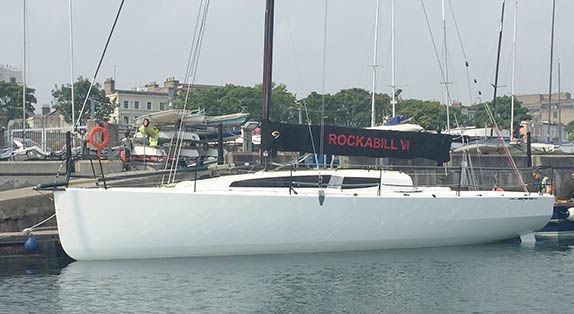 Something completely different – Rockabill VI newly arrived in Dun Laoghaire, April 2016 Photo: Afloat.ie/David O’Brien
Something completely different – Rockabill VI newly arrived in Dun Laoghaire, April 2016 Photo: Afloat.ie/David O’Brien
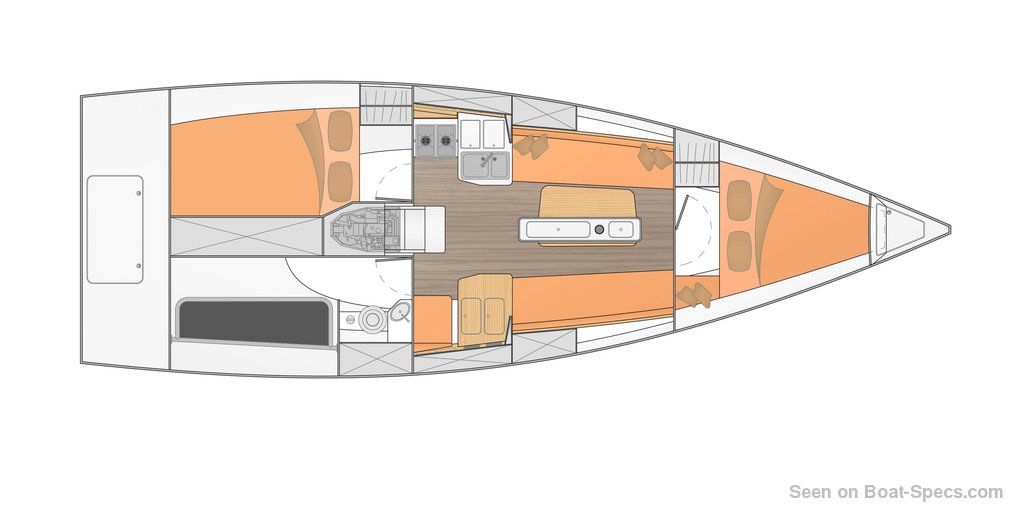 With her strong but light construction and minimalist yet comfortable layout, Rockabill VI represented a new world of offshore racing.
With her strong but light construction and minimalist yet comfortable layout, Rockabill VI represented a new world of offshore racing.
Yet perhaps the best thing of all about having placed his order back in July before the boat was achieving stellar results was that it entitled him to visit the new factory near Lorient where the boat was being built. He went there a number of times, finding it an inspiring place of exceptional cleanliness and precision, while the dedication of designer Jacques Valer and company founder Jean-Pierre Kelbert set an impressive tone.
 The first win – Paul O’Higgins on the helm as his new JPK 10.80 Rockabill VI sweeps into Dublin Bay to record her first offshore win, a cross channel ISORA race in May 2016
The first win – Paul O’Higgins on the helm as his new JPK 10.80 Rockabill VI sweeps into Dublin Bay to record her first offshore win, a cross channel ISORA race in May 2016
To say that Paul O’Higgins was well ahead of the Irish curve in placing such an early order for the JPK 10.80 which was to become Rockabill VI in 2015 is surely under-stating the case. He’d the right boat on the way for delivery in April 2016, and for four years now he has been honing a boat-and-crew management and campaign technique which has been paying increasingly improved dividends, while there’s no doubt that for all his forensic approach to boat selection, he and his many shipmates have developed an affection for Rockabill VI which goes beyond the utilitarian.
“Doing what she does best” - Rockabill VI provides speedy yet controlled sailing in this vid below:
The way that the extensive crew panel is made up is instructive. It’s only very rarely indeed that Paul himself isn’t on board, and with him are the “amateur core” based around his son Conor and Ian O’Meara, while Mark Pettit is the longterm professional, with four times Olympian Mark Mansfield increasingly part of the scene for the last three seasons.
The Flanagan family’s sailing influence continues as Paul’s wife Finola is part of the panel, as too is Mark Pettit’s wife Anna Walsh, who for the past couple of seasons and more has been in charge of the food, as mentioned in last week’s Round Ireland preview.
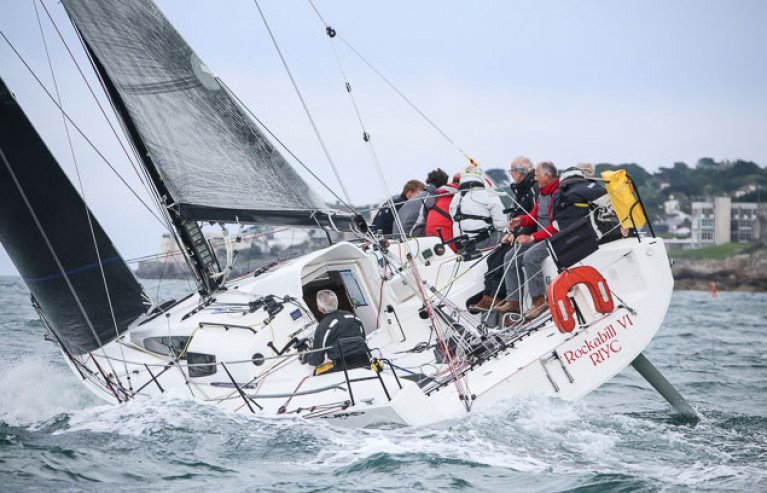 The power team – Rockabill VI with Peter Wilson on the helm and Mark Pettit on mainsheet in the early stages of the D2D Race 2016. Photo: Afloat.ie/David O’Brien
The power team – Rockabill VI with Peter Wilson on the helm and Mark Pettit on mainsheet in the early stages of the D2D Race 2016. Photo: Afloat.ie/David O’Brien Successful combination - Peter Wilson and Paul O’Higgins. Photo: W M Nixon
Successful combination - Peter Wilson and Paul O’Higgins. Photo: W M Nixon
The legendary Peter Wilson was of course on board for the first Dingle Race win in 2017, while other longterm hands who have shown they can fit in with the Rockabill VI way of campaigning include another O’Higgins son, Fergus, together with noted Dun Laoghaire star Kieran Tarbett and the RIYC’s Oisinn Collins. Also there is Conor Kinsella – from Offaly, and originally a Fireball sailor – with James Gunn from Dublin and John Kelly from Cobh.
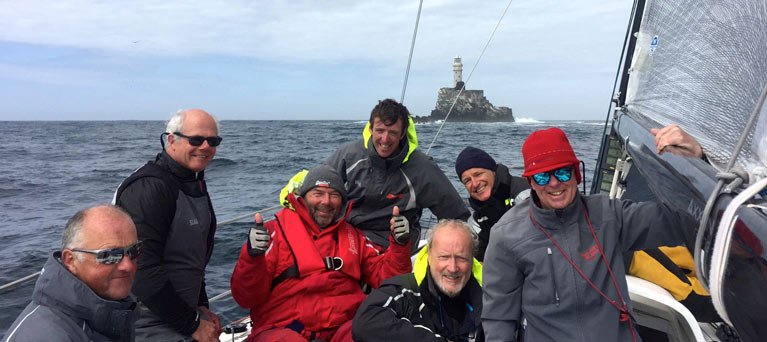 A (very) brief relaxed moment for a crew photo as Rockabill VI (well in the lead) approaches the Fastnet Rock during the 2017 D2D with (left to right) Mark Pettit, Ian O’Meara, Rees Kavanagh, Conor O’Higgins, Peter Wilson, Ian Heffernan and Paul O’Higgins. Photo: Will Byrne
A (very) brief relaxed moment for a crew photo as Rockabill VI (well in the lead) approaches the Fastnet Rock during the 2017 D2D with (left to right) Mark Pettit, Ian O’Meara, Rees Kavanagh, Conor O’Higgins, Peter Wilson, Ian Heffernan and Paul O’Higgins. Photo: Will Byrne
Maintaining viable relationships of friendship and shared purpose with such an eclectic group of shipmates is quite a project in itself, but Paul O’Higgins takes it all in his stride with an affable and interested presence, and an incredibly good memory. 2019 was truly The Beautiful Season for Rockabill VI, but in the way of the O’Higgins campaign style, the focus has long since been on 2020 with its peaks in the SSE Renewables Round Ireland Race and festivities in Cork.
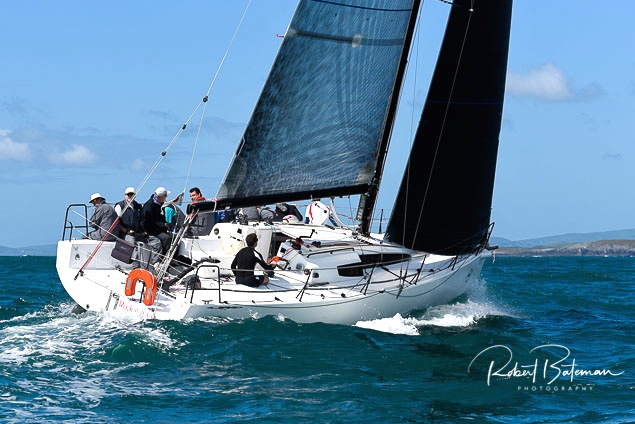 It’s West Cork, and the sun shines – Rockabill on track for victory in Calves Week at Schull. Photo: Robert Bateman
It’s West Cork, and the sun shines – Rockabill on track for victory in Calves Week at Schull. Photo: Robert Bateman
Yet with everything on hold on a day-to-day basis for the time being, this weekend we can cheer ourselves by contemplating the wonder of Rockabill VI’s 2019 season. Perhaps the most attractive aspect of the Paul O’Higgins’ approach is that he’s a genuine sportsman who loves his sailing. Thus although he knows each November that organiser Fintan Cairns will be setting an impossible handicap for Rockabill VI’s challenge in the DBSC annual Turkey Shoot, his love of sailing means he’ll still be out there racing.
Were this a traditional profile of a noted sportsman, we would of course reveal Paul O’Higgins’ age. But when you’re dealing with dedication, enthusiasm, managerial ability and sheer sailing toughness at this level, mere chronological age becomes a meaningless metric. So let’s say that Paul O’Higgins, Afloat.ie/Irish Sailing “Sailor of the Year 2019”, is a life member of the sailing team from Tir na nOg, and that’s all there is to it.
 With Mark Mansfield trimming from the lee deck, Rockabill VI finds just enough breeze to win the final ISORA race of the year – and the championship – in Dublin Bay, September 2019. Photo: Afloat.ie/David O’Brien
With Mark Mansfield trimming from the lee deck, Rockabill VI finds just enough breeze to win the final ISORA race of the year – and the championship – in Dublin Bay, September 2019. Photo: Afloat.ie/David O’Brien
Royal Irish Yacht Rockabill VI is ICRA Boat of the Year
Paul O’Higgins’ JPK1080 Rockabill VI from the Royal Irish Yacht Club on Dublin Bay has won the ICRA Boat of the Year Award to round off a stand out 2019 season.
Rockabill’s wins in the high scoring ICRA Nationals and the offshore Dun Laoghaire to Dingle Race, both in June, contributed to her highest score, all clinched by participating and finishing third in Howth Yacht Club’s Autumn League this month.
Rockabill VI pipped Nigel Biggs’ Half Tonner Checkmate XVIII to claim the title by a single point.
The 2019 ICRA Boat of the Year scored the performance of over 100 boats throughout a tremendous season for Irish yacht racing.
Tope scoring boats in each of the classes were:
- Class 0 – Rockabill VI
- Class 1 – Joker II
- Class 2 – Checkmate XVIII
- Class 3 – F’n Gr8
- White sails – Demelza
The coveted Lighthouse trophy will be presented to Paul O’Higgins and his Rockabill crew at the annual ICRA Conference (date and venue to be confirmed).
 Rockabill VI skipper Paul O'Higgins Photo: Dominick Walsh/D2D
Rockabill VI skipper Paul O'Higgins Photo: Dominick Walsh/D2D
The final scores for all boats are downloadable below.
ICRA updated its Boat of the Year scheme this year to better reflect the national cruiser-racer picture. Now, instead of an annual committee decision, the points from a series of 12 regattas were combined to identify the top-performing boat on IRC across the season balanced between the east, south, west and offshore scenes.
The ICRA Boat of the Year was awarded on a points basis with the top three places in an IRC division at National Championships. National regattas and regional events all count towards the rankings for the year.
Paul O’Higgins (RIYC) is November’s Afloat.ie “Sailor of the Month (Offshore)” for the sporting way he campaigns his JPK 10.80 Rockabill VI.
He knew when to make it serious to win the Volvo Dun Laoghaire to Dingle Race, but equally he won his class in Calves Week as part of a family holiday.
And he gallantly campaigns the DBSC Turkey Shoot as a front runner on the water, but carrying a stratospheric handicap.
The 275-mile Volvo Dun Laoghaire to Dingle Race overall win was still open to challenge until the leader on the water, Paul O’Higgins’ JPK 10.80 Rockabill VI, had cleared the Fastnet Rock. However, with every mile sailed thereafter, it looked increasingly likely that Rockabill was on track to win every title for which she was eligible. Only a total catastrophic failure of boat or equipment was going to prevent it. But there was no failure of any kind. The JPK 10.80 comes at a significant price premium because this is a clearly defined concept which just doesn’t do boat or equipment failures. W M Nixon tries to pin down why the Dingle win seemed so special.
Success has many fathers, while failure is an orphan. As Paul O’Higgins’ JPK 10.80 Rockabill VI has increasingly found her form in Irish sailing since arriving new from the builders just over a year ago, there’s no lack of people ready to tell you how and why they counselled him to go for an expensive new JPK 10.80, rather than a reasonably-priced second-hand J/109 like so many others.
But as one of Dublin’s leading barristers, Paul O’Higgins is his own man, quiet in demeanor yet thinking on his feet at the speed of lightning, while effortlessly storing any new information in a well-furnished brain. His approach to sourcing a new boat as the 2014 season drew to a close was forensic in its analysis, and the way he picked on a JPK 10.80 before they’d hit the headlines of major success is illustrative of how he functions.
Not being a cradle sailor, he can look at boats in a coldly dispassionate way. He hadn’t sailed at all until he met his future wife Finola Flanagan at College, and as the Flanagans of Skerries were the total sailing family, he soon found himself roped into sailing with his future father-in-law Jack Flanagan on a series of boats all named Rockabill after that distinctive lighthouse-topped rocky islet that is eight miles east of Skerries out in the Irish Sea, an islet big enough to provide a home for Europe’s largest colony of the rare roseate terns.
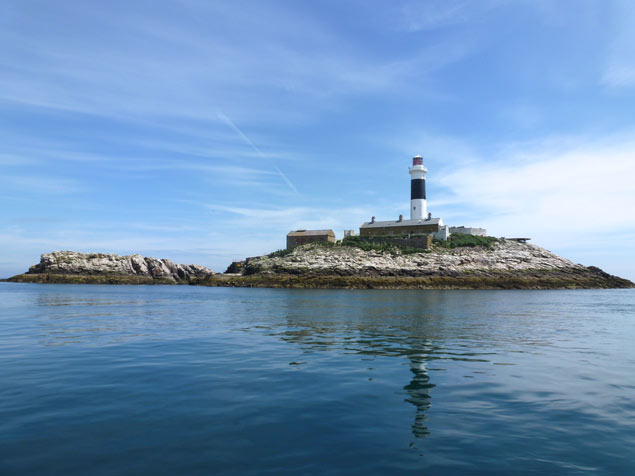 The one and only original Rockabill is still a couple of hundred miles from the Fastnet Rock. Photo: W M Nixon
The one and only original Rockabill is still a couple of hundred miles from the Fastnet Rock. Photo: W M Nixon
From being a visitor who might pull a rope when asked, the daughter’s suitor developed into a crewman, and as his taste for this weird but wonderful sport grew, he became a partner in the continuing succession of Rockabills, going into co-ownership with Jack in a souped-up First 30, Rockabill II.
By 1998, the balance was changing naturally with the passage of time, and Paul was becoming the pace-setter when they moved into a First 33.7 Rockabill III. He was competitive, yet no more naturally able at sport than most. An enthusiasm for playing rugby had been brought to an end by a knee injury, but he can still give a reasonable account of himself on a tennis court. However, it was the hugely complex wind-driven vehicle sport of campaigning a cruiser-racer under fair handicap rules which increasingly appealed to him. Having made the happy discovery that he seemed to be immune to seasickness, he stepped up his level of involvement.
His father-in-law had long since become eligible for the free travel pass, so the stage was reached where Paul bought him out while still with the First 33.7, and then with the turn of the millennium he was thinking of another boat slightly further up the Beneteau range, the highly-regarded First 36.7, and with her he achieved his first significant win in an IRC event.
Professional and family life were at their most demanding, yet somehow he found the time to campaign the First 36.7 Rockabill IV in several significant series and regattas, building up both experience and skills, while at the same time enlarging his circle of like-minded friends to create the kind of crew panel – more than twice the number of actual crew on the day - which is necessary to campaign a serious boat at this level.
With every year, however, the level became ever more demanding, and in admitting to himself that the First 36.7 was no longer cutting the mustard at the heights to which he aspired, he reckoned by 2008 that he needed to be in a Corby, and a new Corby 33 was what he could most comfortably afford.
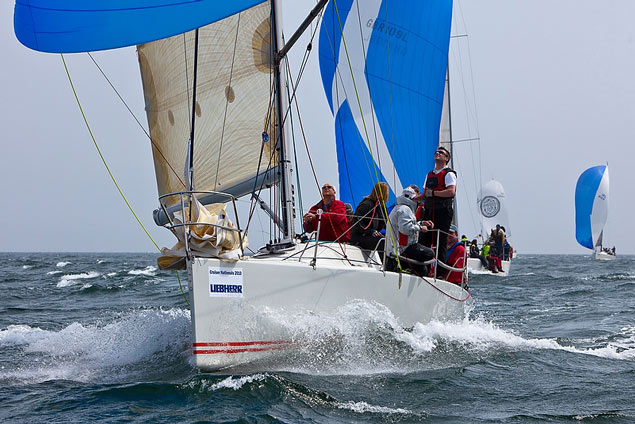 With the Corby 33 Rockabill V, Paul O’Higgins had many successful years. She is seen here racing at the ICRA Nationals 2013 at Tralee Bay. Photo: Robert Bateman
With the Corby 33 Rockabill V, Paul O’Higgins had many successful years. She is seen here racing at the ICRA Nationals 2013 at Tralee Bay. Photo: Robert Bateman
Rockabill V, the Corby 33, became a familiar sight on the circuit, always noted for putting in an interesting and often podium-gaining position, yet almost invariably guaranteed to appear at Calves Week, that amalgam of West Cork Regattas out of Schull early in August, a fun event with an underlying level of quite serious racing which fitted well with the Higgins’ family’s regular summer holidays in West Cork in August.
For a busy man ashore, his commitment to getting afloat as much as possible was remarkable, and his willingness to take part each year in an interesting series of regattas and events saw his crew panel increasing. If you were as keen as Paul O’Higgins, then as a committed panel-member you were going to get sailing. And with first places recorded in various series which ranged from Scotland to Kerry, plus regular participation in Dublin Bay where he sails from the Royal Irish YC, Rockabill V made frequent and regular appearances in the frame.
But by 2014 he began to feel that he’d gone about as far as he could with the Corby 33. She’s a very interesting boat, unforgiving in some ways yet rewarding in others. But nobody would call her luxurious, let alone comfortable. That said, Rockabill V was still winning races. But when a new boat called the JPK 10.80 appeared from a specialist yard in France in the Spring of 2014, his interest was piqued by the fact that she had race potential, yet with her considerable beam, twin rudders, and roomy and comfortable accommodation, was about as different as possible in concept from the Corby.
If he was going to make a change, why not make a complete one? The J/109 seemed an attractive idea, but when the class finally started to take off in Dublin Bay, she was no longer being built. This “new” Dublin Bay One-Design was a class made up entirely of pre-owned boats. Yet Paul O’Higgins had become accustomed to buying from new. Second-hand just wasn’t his thing.
He looked again at the JPK 10.80, and when one of the very first turned up from France to race Cork Week 2014, he was very taken with her despite the fact that in straight sailing, the crew clearly weren’t getting the best from her, while their confusion with Cork Harbour courses compounded their problems.
Paul O’Higgins bided his time until July 2015 when, despite the pressure from the J/109 lobby, he placed an order for a JPK 10.80. It was a decision soon supported by events, with a JPK 10.80 winning the Rolex Fastnet overall in August 2015, and then in December a JPK 10.80 cruising the Pacific was briefly taken out of her cruising reverie, kitted out with racing sails by Gery Trentesaux’s Fastnet-winning crew, and promptly went out and won her class in the Sydney-Hobart Race.
Yet perhaps the best thing of all about having placed his order back in July was that it entitled him to visit the new factory near Lorient where the boat was being built. He went there a number of times, finding it an inspiring place of exceptional cleanliness and precision, while the dedication of designer Jacques Valer and company founder Jean Pierre Kelbert set the tone.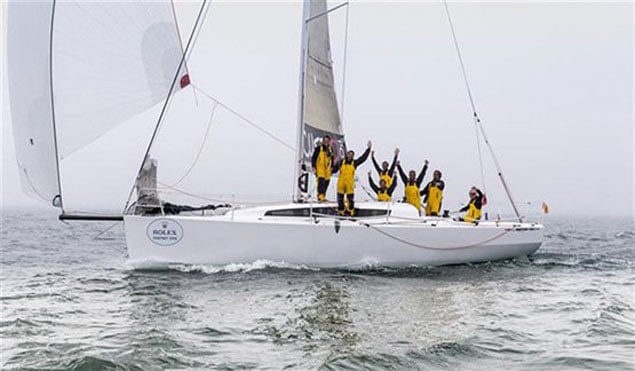 The JPK 10.80 Courier du Leon winning the Fastnet race a month after the order had been placed for Rockabill VI
The JPK 10.80 Courier du Leon winning the Fastnet race a month after the order had been placed for Rockabill VI
Thus although the situation is that an order placed today for a new JPK 10.80 would mean delivery no earlier than the very end of 2018, they are not enthusiastic about taking on extra staff to speed up production. They feel that not everyone would immediately share the JPK ethos, and the current workforce size and output is probably optimal.
 The JPK 10.80’s beamy hull shape with twin rudders was a whole world away from the narrow deep Corby concept.
The JPK 10.80’s beamy hull shape with twin rudders was a whole world away from the narrow deep Corby concept.
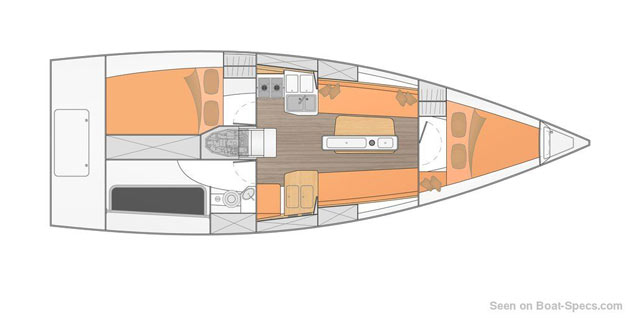 The accommodation is surprisingly roomy and comfortable for a boat which has now added the Dun Laoghaire-Dingle Race win to overall victory in the Fastnet and a class win in the Sydney-Hobart.
The accommodation is surprisingly roomy and comfortable for a boat which has now added the Dun Laoghaire-Dingle Race win to overall victory in the Fastnet and a class win in the Sydney-Hobart.
It may be frustrating for someone who is keen but hasn’t yet made the commitment, but for those already on the ladder or with a JPK 10.80 sailing and winning, it serves to keep the boat’s value very high. You don’t buy a JPK 10.80. You invest in one.
But when Rockabill VI first arrived in Ireland early in the season of 2016, the light airs of her debut event, the ICRA Nationals at Howth, didn’t suit her initial configuration of small sails planned to fit into the preferred IRC Rating band for the best racing in Dublin Bay.
However, for the Round Ireland Race 2016 later in June, she was at her sparkling best for the fast run up the west coast, and seemed to have a class win in the bag when she hit a localised total calm at Inishtrahull. Rockabill VI and a couple of other boats nearby simply sat there for nearly four hours while the closest competition, the J/109 Euro Car Parks (Dave Cullen), came up from very many miles astern with her own breeze to knock Rockabill off the leader perch. With light airs when beating down the Irish Sea, the under-canvassed JPK 10.80 Rockabill VI failed to re-take the class lead.
So although there were many wins in 2016, particularly when there was a good breeze or lots of high-powered offwind stuff, and preferably both, Rockabill VI was on the money, but through the winter Paul O’Higgins implemented a plan to step up the sail area and take the ratings hit.
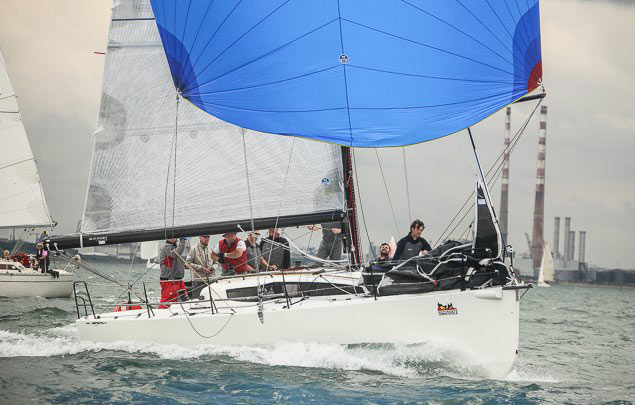 Rockabill VI in the totally familiar surroundings of Dublin Bay Photo: Afloat.ie
Rockabill VI in the totally familiar surroundings of Dublin Bay Photo: Afloat.ie
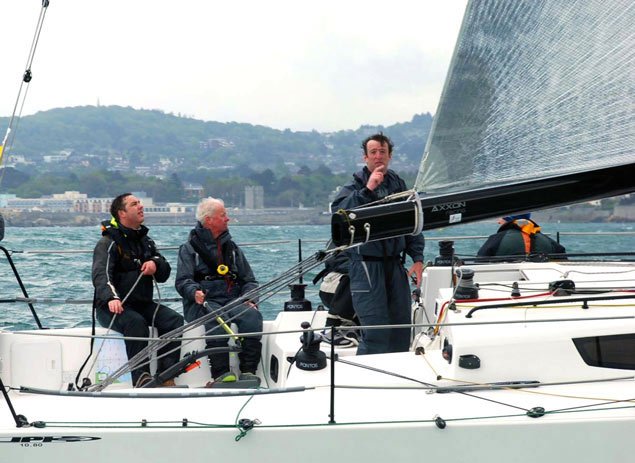 Paul O’Higgins on the tiller as Rockabill VI wins the Holyhead-Dun Laoghaire Race 2017
Paul O’Higgins on the tiller as Rockabill VI wins the Holyhead-Dun Laoghaire Race 2017
Most observers are confident that it will pay ultimately pay off, yet oddly enough there has only been one major race this year in which its success was clearly demonstrated. The Holyhead-Dun Laoghaire – which she won – was a freed-sheet breezy sprint, while the Dun Laoghaire-Arklow was a calm-bedevilled flukerama. So the only true test was the hybrid ISORA Howth-Lambay-Poolbeg race on June 3rd, in which the ISORA fleet sailed Howth YC’s Lambay Race in a gesture to Howth Regatta, but then continued on through the finish line to finish at the Poolbeg Y&BC line as a gesture to the Dublin Port Riverfest.
Hybrid or not, it demonstrated that Rockabill VI’s new configuration was a race winner, but after that there was little opportunity for any further testing before the National YC’s Volvo Dun Laoghaire-Dingle race got under way at 1900hrs on Wednesday June 14th.
We’ve carried at least a dozen continuing reports on Afloat.ie, so there’s no need here to tell you of the ins and outs of a classic race, but what was it like on Rockabill VI, which so convincingly won?
By this stage in a sailing career which has been going on for nearly 35 years, Paul O’Higgins has a trusted crew panel of between 15 and 20 centred on Dublin or Cork upon whom he can draw, and putting together a campaign team of eight for the Dingle Race neatly drew the balance between who was available, who was really keen, and those whose abilities would best complement the core squad which was emerging.
Topping the list was Paul himself and his son Conor, while regular helmsman Mark Pettit was also in from the start. The other main helm became Peter Wilson, whose skills on the tiller or wheel are legendary, and he also brought the kudos of having been a key member of the crew with which Richard Burrows won the very first Dingle Race in 1993 with the Sigma 36 Black Pepper.
Central to the crew was Ian O’Meara of Viking Marine in Dun Laoghaire, who in addition to knowledge of equipment and considerable sailing skills, is married to Jacquie Marsh who heads that very special catering setup, The Butler’s Pantry. Rockabill VI raced with a balanced selection of pre-prepared meals from The Butler’s Pantry, and when feeding time came around, they feasted like kings in the remarkable comfort which this very exceptional boat is able to provide.
Through his contacts on the Dun Laoghaire waterfront, Ian O’Meara had introduced a recent recruit to the crew panel, Will Byrne who was Captain of UCD Sailing in recent years when they’ve been winning every which way. He has also logged offshore racing experience with the RORC programme in the English Channel each summer, and he brought youth and extra skills to the crew for Dingle.
 Will Byrne (right) with his new shipmates at the Fastnet. He was a highly successful Captain of UCD sailing and a veteran of RORC events, but had not sailed the Dingle race before. Photo: Paul O’Higgins
Will Byrne (right) with his new shipmates at the Fastnet. He was a highly successful Captain of UCD sailing and a veteran of RORC events, but had not sailed the Dingle race before. Photo: Paul O’Higgins
Two frequent crew regulars on Rockabill – Rees Kavanagh who knows his way round many boats, and Ian Heffernan who is a professional maritime instructor, made up the total of eight. They were divided into a rolling system of pairing which means that at any one time, there’s always a minimum of four on deck, but proper off-watch spells are guaranteed, as Rockabill VI is laid out in such a way that three people can be fully off-watch and sleeping, yet they’re right up against the weather side of the boat.
This may sound self-indulgent for people who expect to spend a night on the weather rail, but it was part of the formula which contributed to Rockabill’s success. As Paul O’Higgins puts it:
“You really do get a proper little spell of sleep. To begin with, the boat is so well built there is no water finding its way below. Troublesome drips from above are unknown. You won’t find the sleeping bag is slowly dampening from some hidden little puddle. And within the limits of slugging to windward off Ireland’s south coast, she’s as sea-kindly as can be, particularly when you have helmsmen of world quality who know that a banging boat is a slow boat.
But always, there’s the reassurance of knowing how well she is built. She’s definitely not going to fall asunder under you and about you. There’s no better recipe for a refreshing sleep when it’s your turn to be off watch”.
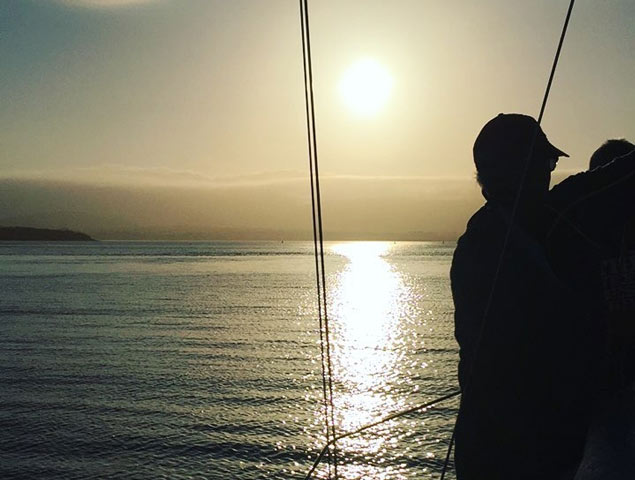 Perfect end to a great race. Summer evening as seen from Rockabill VI heading into Dingle. Photo: Will Byrne
Perfect end to a great race. Summer evening as seen from Rockabill VI heading into Dingle. Photo: Will Byrne
Thus Rockabill VI’s inbuilt advantage over the opposition simply increased as the race went on. Others were giving it best and retired as the going got tough and stayed tough, but on Rockabill, they were on top of it - and enjoying it too.
That said, with the increased rating, they knew that they were vulnerable to any unexpected calm and the constant challenge of the three chasing J/109s, to all of whom they gave quite a bit of time. It was an itch to be scratched .The owner-skipper at his navigation and tactics took to referring to the nearest one, Peter Dunlop & Vicky Cox’s Mojito, as Mosquito.....
Yet most of the time, Rockabill was stretching her lead on Mosquito. When she got to the Fastnet towards 1000 hrs on the Friday morning, they’d lengthened it to eleven miles. A celebratory crew photo with the rock in the background was assembled by Will Byrne, but helmsman Mark Pettit, a very serious person, thought such frivolity was premature.
Evidently the Fastnet Rock agreed with him. It served up a slack patch and a very lumpy sea, and for an agonising period their speed dropped to 3.8 knots. But they got clear of its clutches, and the notorious flat at Mizen Head only slowed them back to 4.4 knots for a while.
And then they were gone, piling on the knots in a warm southwesterly which became stronger the nearer they got to the finish. They came past Skellig Michael at 8.8 knots. The last nine miles into Dingle were seen off in less than fifty minutes. They’d won everything by a country mile and then some. After the finish, they were lined up for photos. History was made. Mark Pettit smiled.
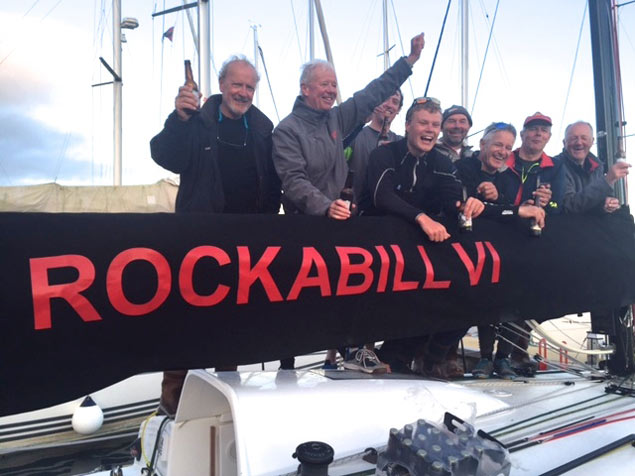 History is made. Mark Pettit (right) is recorded as smiling (well, sort of) at the crew-lineup in Dingle. Others in the photo are (left to right) Peter Wilson, Paul O’Higgins, Will Byrne, Conor O’Higgins, Ian Heffernan, Rees Kavanagh and Ian O’Meara. Photo: Con Murphy
History is made. Mark Pettit (right) is recorded as smiling (well, sort of) at the crew-lineup in Dingle. Others in the photo are (left to right) Peter Wilson, Paul O’Higgins, Will Byrne, Conor O’Higgins, Ian Heffernan, Rees Kavanagh and Ian O’Meara. Photo: Con Murphy
The plans for the rest of the season are very conservative, for this is first and last a Corinthian boat. As a busy lawyer, Paul O’Higgins’ free time is constrained, and he reckons something like a Fastnet campaign is simply too demanding of time, money and other resources when the energy would give a better return deployed in other ways, and his family have always had other ways of being near the Fastnet Rock during August.
So Rockabill VI will return to Dun Laoghaire for DBSC racing, the Volvo Dun Laoghaire Regatta preceded by ISORA’s Lyver trophy Race, some other ISORA events, and then full-on participation in Calves Week out of Schull as part of a family holiday in West Cork, when the boat’s excellent cruising potential will also be utilised.
It’s Irish sailing at its best. This is how it should be done. Topped off with the Dingle Race win before midsummer was even upon us, it’s a very attractive balance.
Read our 2017 Dun Laoghaire–Dingle Race Reports in one handy link here
Rockabill VI Gets To Dingle In Time For Dinner
#D2D - In Dingle of a warm summer Friday’s evening, the night has barely started at 9pm, writes W M Nixon. So the multi-talented crew of Paul O’Higgins’ JPK1080 Rockabill VI were in plenty of time for a leisurely winner dinner when they swept across the finish line in the Volvo Dun Laoghaire to Dingle Race 2017 at 2048 hrs to stake what looks like an unassailable claim to have won just about everything in this race for which they’re eligible.
There have been Dingle Races in the past where the nearer you got to the finish, the more difficult it was to find enough breeze to close the race. But this time round, Rockabill VI has found such sparkling conditions towards the end that, with a warm yet brisk fair wind sweeping her up the majestic Dingle Bay, she covered the last nine miles in less than an hour.
Considering the miserable conditions everyone was enduring only 30 or so hours ago, it was an almost supernatural change to the weather. But with this crew and this rather special boat, Paul O’Higgins had the combination to make the best of the rough going, and yet have some real champagne sailing when the weather improved.
The crew who shared this victory with him were Conor O’Higgins, Mark Pettit, Ian O’Meara, Peter Wilson, William Byrne, Rees Kavanagh, and Ian Heffernan. Many have done the Dingle race before, with some of them winning in times past. Many will do it again. But the totality of Rockabill VI’s win — with line honours thrown in despite the fleet having started with many larger boats — is more than enough to be going along with for now.
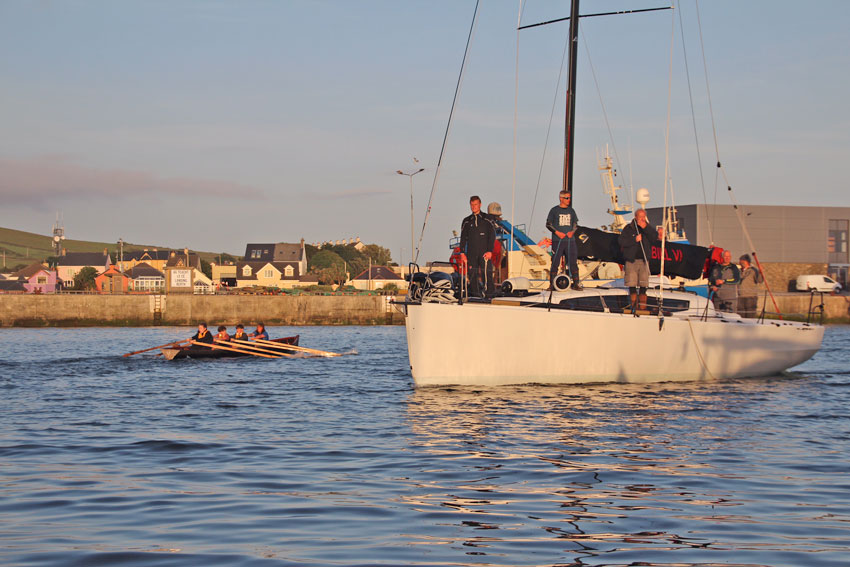 Rockabill VI coming into dock earlier this evening | Photo: Rebecca Hayter
Rockabill VI coming into dock earlier this evening | Photo: Rebecca Hayter
The mainly southwest breeze is distinctly firmer the further north you go, and back at Mizen Head a surprisingly persistent flat patch has provided an obstacle at which nearly everyone has stumbled. Thus as Rockabill came careening into the finish, back at the Mizen, Rónán Ó Siochrú of Irish Offshore Sailing, with his school yacht the Jennneau 37 Desert Star, was finding the going very sticky at just 3.4 knots. It was very frustrating after the very businesslike way he came past the Fastnet to take the Racing 2 lead from Ian Hickey’s Granada 38 Cavatina, which is herself now (at 2100 hrs) at the Fastnet Rock, and back in the Racing 2 lead.
In the cruising division, the Tyrrell family’s J/112E Aquelina lost the lead to the Dufour 40 Pipedreamer (Paul Sutton) thanks to an unscheduled slowdown at Mizen Head. But there’s a long way to go yet for these mid-fleet boats.
Up in front, the Two-Handed Division leader Soufriere (Stephen O’Flaherty & David Cagney) is sailing in a style which befits a stately Spirit 54, and she’s there in a bunch with various J/109s of which the leader is Mojito (Peter Dunlop & Vicky Cox), which now seems firmly placed to take second overall, but by this time quite a distance astern of Rockabill VI.
It has been, and continues to be, an intriguing edition of the Dingle race which will be worthy of further analysis. But for now, the night is Rockabill VI’s, and she won it well.
Read all Afloat.ie's 2017 Dun Laoghaire to Dingle Race coverage in one handy link here
Paul O’Higgins’ JPK 10.50 Rockabill VI has opened out a ten mile lead on the first of the chasing J/109s Mojito (Peter Dunlop and Vicky Cox) in the Volvo Dun Laoghaire to Dingle Race 2017 writes W M Nixon. In approaching Dursey Head, the Rockabill crew are sensibly taking the option of giving the headland a wide berth, as going too close to such a steep coastline can result in both wind shadow, and an even more confused sea state at the point itself.
Ten miles astern at Mizen head, Mojito is nearer to the land and her speed has fallen to 5.1 knots while Rockabill continues reaching at a brisk 7 knots in an easing southwesterly breeze which may see her speed reduced shortly, as Valentia is reporting a 9 mph southerly.
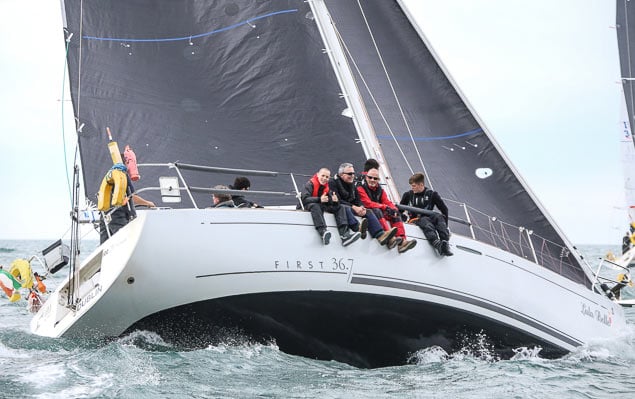 Liam Coyne's Lulabelle sailed into Kinsale to make repairs and is continuing in the race. The former RORC Round Britain and Ireland race winner brought his 13–year–old son along for his first offshore experience – what a debut!
Liam Coyne's Lulabelle sailed into Kinsale to make repairs and is continuing in the race. The former RORC Round Britain and Ireland race winner brought his 13–year–old son along for his first offshore experience – what a debut!
However, Valentia wind reports have to be taken with a dose of salt, as the actual met station is not on Valentia Island, but in the western suburbs of Cahirsiveen. It’s an impressive looking setup, but there’s no way it is recording the actual wind conditions on Valentia Island’s Atlantic coasts.
As for the rest of the fleet still in this demanding race, Stephen O’Flaherty and David Cagney in the Spirit 54 Soufriere pulled off a good move in laying out to sea last night, as they found the new sou’wester which has brought them in as neat as you please past the Fastnet in company with the other J/109s Juggerknot (Andrew Algeo) and Ruth (Ben Shanahan), which had struggled a bit to find their way out from hugging the coast.
Thus Soufriere now leads the Two-Handed Division from Derek and Conor Dillon with the Dehler 34 Big Deal, but with the wind continuing to ease it’s going to be quite a challenge keeping the big long Soufriere travelling well in the confused leftover sea. And even while we’ve been writing this at 1515 hrs, the challenges being faced are very evident with Mojito briefly in a flat spot at the Mizen with her speed down to a knot, but Soufriere and Rockabill continue at 6.5 knots.
ICRA’s 'Boat Of The Year'? You Choose
The Annual Conference of the Irish Cruiser Racer Association (ICRA), an absorbing all-day affair in Limerick this Saturday (March 4th), has an intriguing agenda writes W M Nixon. But for many sailors from all over Ireland and the other side of the Irish Sea, the high point of it all will be the announcement of the ICRA “Boat of the Year” selected by the ICRA judges.
We revive memories of the great year of 2016 by running our own informal poll - just click as you wish on this alphabetic list at the bottom of this story to see whose achievements rise up the ranking. We can only say that that the wealth of choice speaks highly of the great good health and re-growing popularity of “waterborne truck racing”
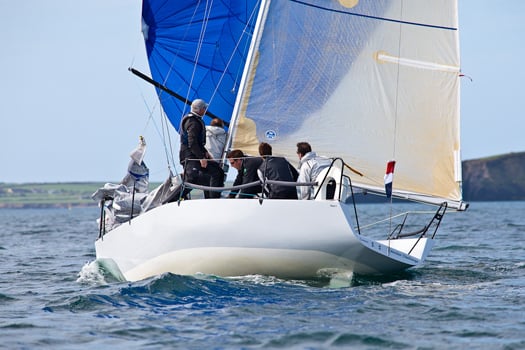 QUARTER TONNER Anchor Challenge – Paul Gibbons from Royal Cork Yacht Club. Photo: Bob Bateman
QUARTER TONNER Anchor Challenge – Paul Gibbons from Royal Cork Yacht Club. Photo: Bob Bateman
Anchor Challenge: Paul Gibbon’s classic Quarter Tonner from Crosshaven was good on enthusiasm, and good on performance, her top line being the overall win in the IRC Europeans at Crosshaven in July, which he plans to defend at Marseilles this summer.
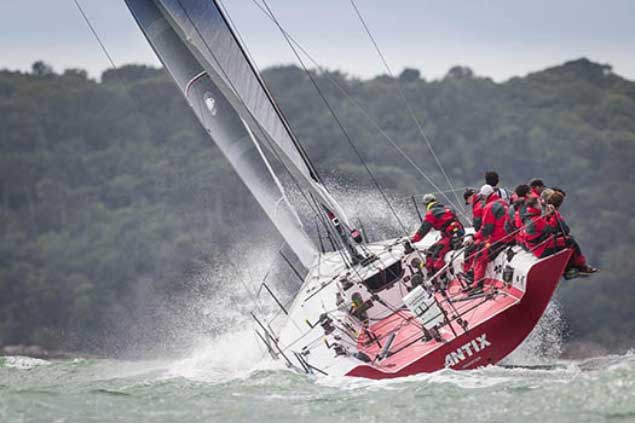 KER39 Antix – Anthony O'Leary from Royal Cork Yacht Club. Photo: Paul Wyeth
KER39 Antix – Anthony O'Leary from Royal Cork Yacht Club. Photo: Paul Wyeth
Antix: Anthony O’Leary’s Fast Forty+ may not have had her most successful season ever in 2016, but many crews would give their eye teeth to have a record as good, topped with the Class O win in the IRC Europeans in Cork Harbour in July.
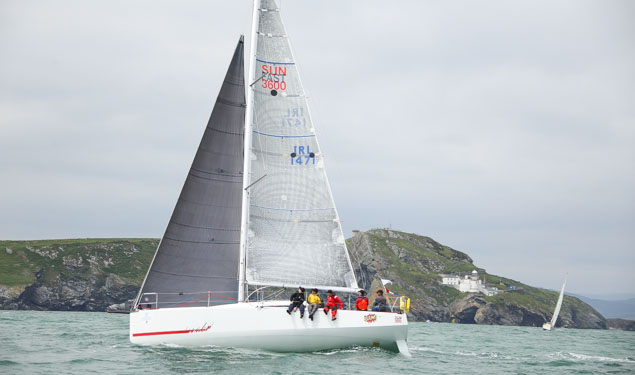 SUNFAST 3600 BAM! - Conor Fogerty from Howth Yacht Club. Photo: Afloat.ie
SUNFAST 3600 BAM! - Conor Fogerty from Howth Yacht Club. Photo: Afloat.ie
Bam!: With the complexities of the RORC Caribbean 2017 still fresh upon us, we realize just how good was Conor Fogerty’s Class win in 2016 in this demanding maze of a race around the islands with his Sunfast 3600 Bam!. And on top of that, it was all just part of an extraordinary season with thousands and thousands of miles of sailing and racing
 HALF TONNER Checkmate XV – David Cullen from Howth Yacht Club. Photo: Afloat.ie
HALF TONNER Checkmate XV – David Cullen from Howth Yacht Club. Photo: Afloat.ie
Checkmate XV: David Cullen’s beautifully-presented classic Half Tonner Checkmate XV found form to rocket to the top in the ICRA Nats at his home port of Howth in June in a very convincing style. Dave also skippered the J/109 Storm to a class win in the Volvo Round Ireland as Euro Carparks, but maybe that should count as a success for the Kelly family’s Storm, which also won the J/109 Nationals
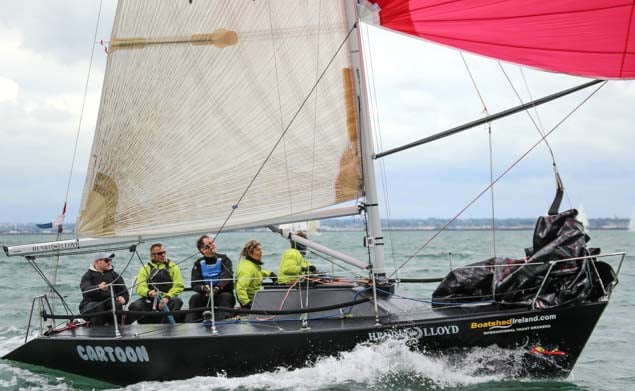 QUARTER TONNER Cartoon – Ken Lawless & Sybil McCormack from the Royal Irish Yacht Club. Photo: Afloat.ie
QUARTER TONNER Cartoon – Ken Lawless & Sybil McCormack from the Royal Irish Yacht Club. Photo: Afloat.ie
Cartoon V: Ken Lawless & Sybil McCormack (RIYC) with their characterful Quarter Tonner came sweeping through the IRC Nationals to win their class in style.
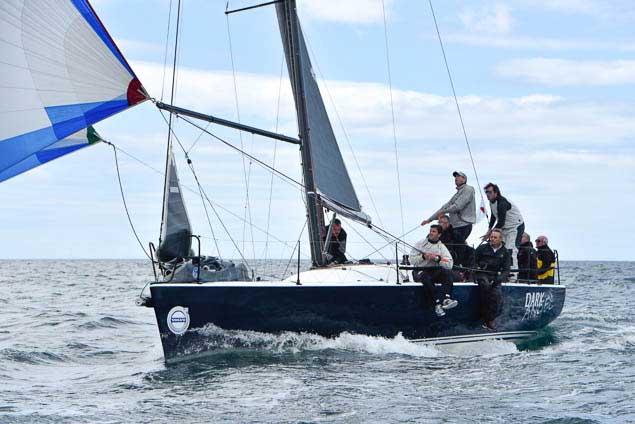 DUBOIS 37 Dark Angel – Tony Ackland from Swansea. Photo: Bob Bateman
DUBOIS 37 Dark Angel – Tony Ackland from Swansea. Photo: Bob Bateman
Dark Angel: Tony Ackland from Swansea turned all heads with his handsome boat which in a previous life was well known in both Cork Harbour and Galway. There’s more than just looks to the Angel – she won IRC 1 in the Europeans at Crosshaven.
 HALF TONNER Harmony – Jonny Swan from Howth Yacht Club. Photo: Bob Bateman
HALF TONNER Harmony – Jonny Swan from Howth Yacht Club. Photo: Bob Bateman
Harmony: Jonny Swan’s wooden-built classic Half Tonner Harmony benefitted from an under-deck laminated fore-and-aft girder installed by Dougal McMahon of Belmont in County Offaly literally to provide a bit of backbone, and it worked a treat. In many victories, Harmony won IRC 3 in the Europeans at Cork.
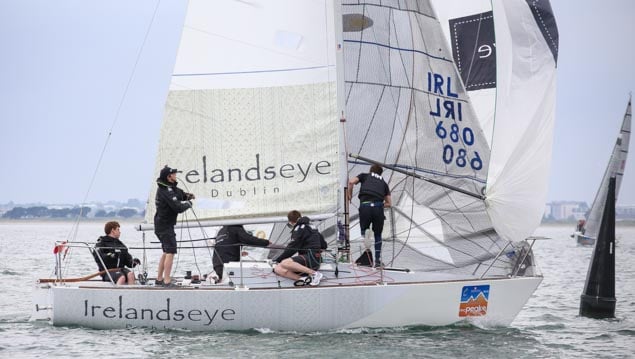 J24 Ireland's Eye Kilcullen – HYC under-25s from Howth Yacht Club
J24 Ireland's Eye Kilcullen – HYC under-25s from Howth Yacht Club
Ireland’s Eye Kilcullen: The HYC nippers – aka the under-25s – in the club-backed J/24 showed there’s still life in this classic Johnstone design. In open events they took second place in Class 4 at Cork Week and the IRC Europeans, they also took third overall in the J/24 Under 25 Europeans. And in the class in Ireland they won the Nationals (7 wins in 7 races), the Northerns, the Southerns, and the Westerns.
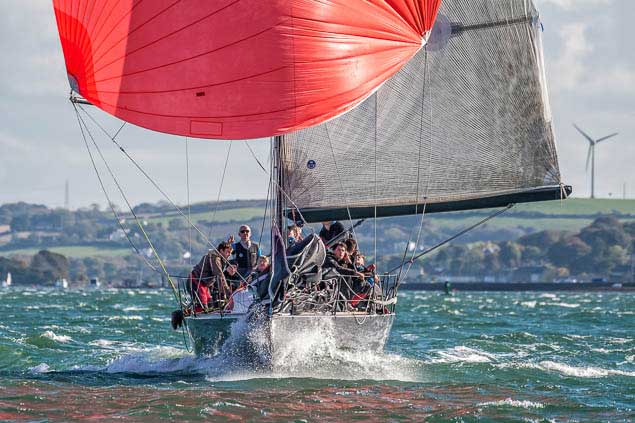 KER36 Jump Juice - Conor Phelan from Royal Cork Yacht Club. Photo: Bob Bateman
KER36 Jump Juice - Conor Phelan from Royal Cork Yacht Club. Photo: Bob Bateman
Jump Juice: Like good wine, Conor Phelan’s Ker 36 from Cork improves with age. They won the RORC Easter Challenge in ferocious weather in the Solent overall, and they won Class O in convincing style at the ICRA Nats in June.
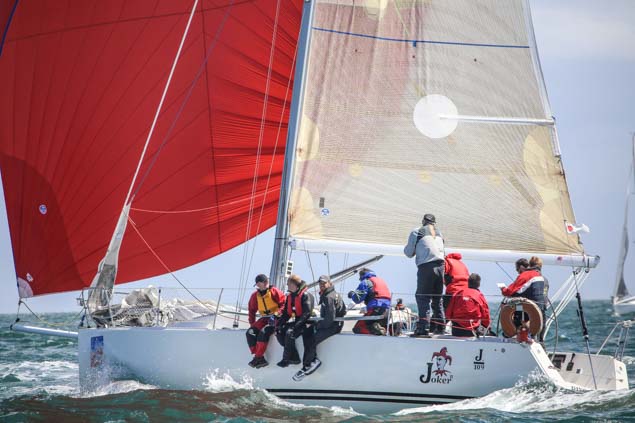 J109 Joker 2 - John Maybury from the Royal Irish Yacht Club. Photo: Afloat.ie
J109 Joker 2 - John Maybury from the Royal Irish Yacht Club. Photo: Afloat.ie
Joker 2: If you wanted a demonstration of the J/109’s all round ability, John Maybury’s Joker 2 provided it in 2016. She recorded a back-to-back win in the ICRA Nats – the only boat to do so in 2015-2016 – and under the skippering of Commandant Barry Byrne, she was the first winner of the new inter-forces Beaufort Cup including winning its Fastnet Race. Same boat, but completely different crews – Joker 2 makes a special claim for top boat of the year
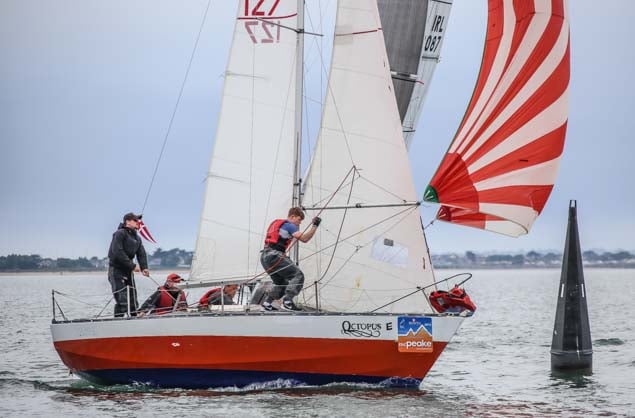 E–BOAT OctopussE - Pat O’Neill from Clontarf Yacht & Boat Club. Photo: Afloat.ie
E–BOAT OctopussE - Pat O’Neill from Clontarf Yacht & Boat Club. Photo: Afloat.ie
OctopussE: The Julian Everitt-designed E Boat is a blast from the past, a miniature offshore racer in which the vertical keel can be retracted completely into the hull. The fleet at Clontarf deserve every credit for their multiple use, including club racing and canal cruising. But it is Pat O’Neill who carries it all through with competition in the ICRA Nats, and he won IRC 4.
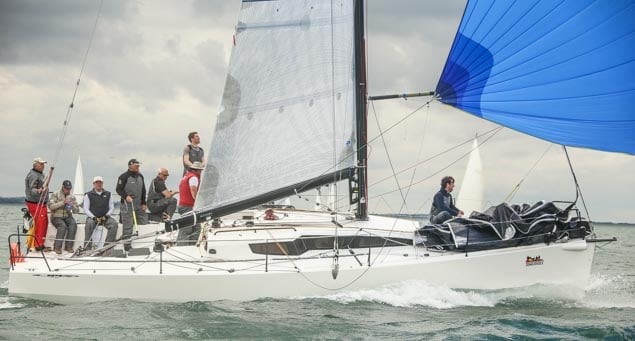 JPK 10.80 Rockabill – Paul O'Higgins from the Royal Irish Yacht Club. Photo: Afloat.ie
JPK 10.80 Rockabill – Paul O'Higgins from the Royal Irish Yacht Club. Photo: Afloat.ie
Rockabill VI: It takes courage to start racing in a boat with a massive international success record like the JPK 10.80, but Paul O’Higgins was game for the challenge when he took Rockabill VI fresh out of the wrappings to do the Volvo Round Ireland Race in June, and came within an ace of a class win. He then re-surfaced for the IRC Europeans at Cork in July – and won IRC 2.
- Votes: (0%)
- Votes: (0%)
- Votes: (0%)
- Votes: (0%)
- Votes: (0%)
- Votes: (0%)
- Votes: (0%)
- Votes: (0%)
- Votes: (0%)
- Votes: (0%)
- Votes: (0%)
- Votes: (0%)


| Total Votes: | |
| First Vote: | |
| Last Vote: |
Royal Irish Yacht Rockabill VI Makes Great Start To Calves Week
GAS Calves Week 2016 started today with a final fleet of 73 cruisers in 6 fleets presenting for the racing arranged once again by Principal Race Officer Neil Prendiville and team. With an increased UK presence and new boats travelling from harbours around the Irish coast, the four–day Regatta, already an established event on many cruisers' annual calendar, has extended its reach.
After the heavy rain of the previous day, the conditions and visibility had improved considerably. Despite this, a number of the lead boats had to rely on GPS to locate the pre-positioned windward mark to the south of Long Island in the middle of Roaringwater Bay. The fleets started outside Copper Point and sent on a long windward beat and then around the Calf Islands once, twice or three times. Given the light wind conditions, varying between 6 and 14 knots, and between W and WNW as the race proceeded, a heavy swell and the flooding tide, tactical positioning counted heavily for those in a position to feature in the places. Honours were spread fairly evenly between clubs sending representatives.
Paul O'Higgins (RIYC) in his new JPK 10.80 Rockabill VI secured honours in both Class 0/1 IRC and ECHO in these difficult conditions, ahead of two Royal Cork boats, True Penance (Darrer/Garvey) in IRC and Altair (Dorgan/Losty) in ECHO. RCYC however swept honours in Class 2, with J80 Rioja (Baxter/Dillon) winning ECHO honours ahead of Galway Bay's Rob Allen on Smile, but losing out to fellow Crosshaven skipper Frank Desmond on his Sunfast 32, Bad Company.
RCYC also took IRC honours in Class 3 with the Lane/Enright partnership on J24 YouGottaWanna, edging out Tralee Bay's Boojum, the Sigma 33 of David Buckley. Local boats featured in the ECHO contest, with the Quinlan consortium on Quinsea (SHSC) winning the honours ahead of John Molloy's Holland 25, Manzanita. In Class 4 IRC, local boat, Sadler 32 Raffles (Tom Kirby/Sean Norris) was ahead of Kinsale Yacht Club Saoirse with Richard Hanley. In ECHO, however, Kirby and Norris had to settle for second place behind local rivals, O Buckley on Tete a Tete (SHSC).
In the hotly contested Whitesail categories, the conditions suited Bob Rendell's XC45 Samatom (HYC) ahead of Sean O'Riordan's YDream (KYC) in IRC. Brian Heffernan on Aisling (RCYC) took ECHO honours ahead of Dublin based Philip Smith on Just Jasmine (RIYC). In Whitesail 2, which is ECHO only, Kinsale Yacht Club shared the honours with Stephen Lysaght's Reavra ahead of John O'Regan on Main 4.































